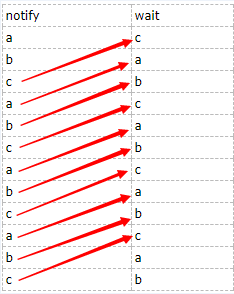Java的Object类
public class Object { public final native void notify(); public final native void notifyAll(); public final native void wait(long timeout) throws InterruptedException; }
调用这些方法的当前线程必须拥有此对象监视器,否则将会报java.lang.IllegalMonitorStateException exception
wait;
Object的wait方法有三个重载方法,其中一个方法wait() 是无限期(一直)等待,直到其它线程调用notify或notifyAll方法唤醒当前的线程;另外两个方法wait(long timeout) 和wait(long timeout, int nanos)允许传入 当前线程在被唤醒之前需要等待的时间,timeout为毫秒数,nanos为纳秒数。
wait():释放占有的对象锁,线程进入等待池,释放cpu,而其他正在等待的线程即可抢占此锁,获得锁的线程即可运行程序。
而sleep()不同的是,线程调用此方法后,会休眠一段时间,休眠期间,会暂时释放cpu,但并不释放对象锁。也就是说,在休眠期间,其他线程依然无法进入此代码内部。休眠结束,线程重新获得cpu,执行代码。
wait()和sleep()最大的不同在于wait()会释放对象锁,而sleep()不会!
notify:
notify方法只唤醒一个等待(对象的)线程并使该线程开始执行。
调用notify()后,并不会立即释放锁,而是继续执行当前代码,直到synchronized中的代码全部执行完毕,才会释放对象锁。JVM则会在等待的线程中调度一个线程去获得对象锁,执行代码。
需要注意的是,wait()和notify()必须在synchronized代码块中调用。
所以如果有多个线程等待一个对象,这个方法只会唤醒其中一个线程,选择哪个线程取决于操作系统对多线程管理的实现。
notifyAll:
notifyAll 会唤醒所有等待(对象的)线程,尽管哪一个线程将会第一个处理取决于操作系统的实现。
这些方法可以使用于“生产者-消费者”问题,消费者是在队列中等待对象的线程,生产者是在队列中释放对象并通知其他线程的线程。
demo:
public class Main { public static void main(String[] args) { Message msg = new Message("process it"); Waiter waiter = new Waiter(msg); new Thread(waiter,"waiterThread").start(); Waiter waiter1 = new Waiter(msg); new Thread(waiter1, "waiter1Thread").start(); Notifier notifier = new Notifier(msg); new Thread(notifier, "notifierThread").start(); System.out.println("All the threads are started"); } } class Message { private String msg; public Message(String str){ this.msg=str; } public String getMsg() { return msg; } public void setMsg(String str) { this.msg=str; } } class Waiter implements Runnable{ private Message msg; public Waiter(Message m){ this.msg=m; } @Override public void run() { String name = Thread.currentThread().getName(); synchronized (msg) { try{ System.out.println(name+" waiting to get notified at time:"+System.currentTimeMillis()); msg.wait(); }catch(InterruptedException e){ e.printStackTrace(); } System.out.println(name+" waiter thread got notified at time:"+System.currentTimeMillis()); //process the message now System.out.println(name+" processed: "+msg.getMsg()); } } } class Notifier implements Runnable { private Message msg; public Notifier(Message msg) { this.msg = msg; } @Override public void run() { String name = Thread.currentThread().getName(); System.out.println(name+" started"); try { Thread.sleep(1000); synchronized (msg) { msg.setMsg(name+" Notifier work done"); msg.notify(); // msg.notifyAll(); } } catch (InterruptedException e) { e.printStackTrace(); } } }

All the threads are started waiter1Thread waiting to get notified at time:1480592377675 waiterThread waiting to get notified at time:1480592377677 notifierThread started waiter1Thread waiter thread got notified at time:1480592378685 waiter1Thread processed: notifierThread Notifier work done
Notifier中的run方法改成msg.notifyAll();
Result:

All the threads are started waiter1Thread waiting to get notified at time:1480592533780 waiterThread waiting to get notified at time:1480592533780 notifierThread started waiterThread waiter thread got notified at time:1480592534782 waiterThread processed: notifierThread Notifier work done waiter1Thread waiter thread got notified at time:1480592534782 waiter1Thread processed: notifierThread Notifier work done
一个通知线程,3个等待线程:
public class Main { private String flag[] = { "true" }; public static void main(String[] args) { System.out.println("Main Thread Run!"); Main test = new Main(); System.nanoTime(); NotifyThread notifyThread =test.new NotifyThread("notify01"); WaitThread waitThread01 = test.new WaitThread("waiter01"); WaitThread waitThread02 = test.new WaitThread("waiter02"); WaitThread waitThread03 = test.new WaitThread("waiter03"); notifyThread.start(); waitThread01.start(); waitThread02.start(); waitThread03.start(); } class NotifyThread extends Thread{ public NotifyThread(String name) { super(name); } public void run() { try { sleep(3000);//推迟3秒钟通知 } catch (InterruptedException e) { e.printStackTrace(); } synchronized (flag) { flag[0] = "false"; flag.notifyAll(); } } } class WaitThread extends Thread { public WaitThread(String name) { super(name); } public void run() { synchronized (flag) { while (flag[0] != "false") { System.out.println(getName() + " begin waiting!"); long waitTime = System.currentTimeMillis(); try { flag.wait(); } catch (InterruptedException e) { e.printStackTrace(); } waitTime = System.currentTimeMillis() - waitTime; System.out.println("wait time :" + waitTime); } System.out.println(getName() + " end waiting!"); } } } }

Main Thread Run! waiter01 begin waiting! waiter02 begin waiting! waiter03 begin waiting! wait time :2999 waiter03 end waiting! wait time :2999 waiter02 end waiting! wait time :2999 waiter01 end waiting!
=====================================================================================
wait和sleep的demo:
public class Main { public static void main(String[] args) { new Thread(new Thread1()).start(); try { Thread.sleep(5000); } catch (Exception e) { e.printStackTrace(); } new Thread(new Thread2()).start(); } private static class Thread1 implements Runnable{ @Override public void run(){ synchronized (Main.class) { System.out.println("enter thread1..."); System.out.println("thread1 is waiting..."); try { //调用wait()方法,线程会放弃对象锁,进入等待此对象的等待锁定池 Main.class.wait(); } catch (Exception e) { e.printStackTrace(); } System.out.println("thread1 is going on ...."); System.out.println("thread1 is over!!!"); } } } private static class Thread2 implements Runnable{ @Override public void run(){ synchronized (Main.class) { System.out.println("enter thread2...."); System.out.println("thread2 is sleep...."); //只有针对此对象调用notify()方法后本线程才进入对象锁定池准备获取对象锁进入运行状态。 Main.class.notify(); //================== //区别 //如果我们把代码:Main.class.notify();给注释掉,即Main.class调用了wait()方法,但是没有调用notify() //方法,则线程永远处于挂起状态。 try { //sleep()方法导致了程序暂停执行指定的时间,让出cpu该其他线程, //但是他的监控状态依然保持者,当指定的时间到了又会自动恢复运行状态。 //在调用sleep()方法的过程中,线程不会释放对象锁。 Thread.sleep(5000); } catch (Exception e) { e.printStackTrace(); } System.out.println("thread2 is going on...."); System.out.println("thread2 is over!!!"); } } } }

enter thread1... thread1 is waiting... enter thread2.... thread2 is sleep.... thread2 is going on.... thread2 is over!!! thread1 is going on .... thread1 is over!!!
wait,notify的使用,线程同步唤醒
package com.qhong; /** * Created by Administrator on 2017/7/4 0004. */ public class MyThreadPrinter2 implements Runnable { private String name; private Object prev; private Object self; private MyThreadPrinter2(String name, Object prev, Object self) { this.name = name; this.prev = prev; this.self = self; } @Override public void run() { int count = 10; while (count > 0) { synchronized (prev) { synchronized (self) { System.out.print(name); count--; self.notify(); } try { prev.wait(); } catch (InterruptedException e) { e.printStackTrace(); } } } } public static void main(String[] args) throws Exception { Object a = new Object(); Object b = new Object(); Object c = new Object(); MyThreadPrinter2 pa = new MyThreadPrinter2("A", c, a); MyThreadPrinter2 pb = new MyThreadPrinter2("B", a, b); MyThreadPrinter2 pc = new MyThreadPrinter2("C", b, c); new Thread(pa).start(); Thread.sleep(1000); //确保按顺序A、B、C执行 new Thread(pb).start(); Thread.sleep(1000); new Thread(pc).start(); Thread.sleep(1000); } }
Output:

ABCABCABCABCABCABCABCABCABCABC
Thread.sleep(100)是保证ABC的执行顺序
在这个例子中,可以深刻的体现出wait不仅是阻塞线程,更体现wait释放锁对象。
比如是4轮,第一轮的abc是有Thread.sleep来控制的,这个时候只有锁对象c是被释放的,锁对象a阻塞线程B,锁对象b阻塞线程C
第二轮,a的prev是c,所以是可以运行的,并且在这一步释放锁对象a,锁对象c注释线程A
................
就这样一轮一轮的控制,虽然想通了,但是让我写还是想不出来的,挺繁琐!
有是一个demo
package com.qhong.thread; public class MyWaitNotify{ MonitorObject myMonitorObject = new MonitorObject(); boolean wasSignalled = false; public void doWait(){ synchronized(myMonitorObject){ while(!wasSignalled){ try{ myMonitorObject.wait(); } catch(InterruptedException e){...} } //clear signal and continue running. wasSignalled = false; } } public void doNotify(){ synchronized(myMonitorObject){ wasSignalled = true; myMonitorObject.notify(); } } } class MonitorObject{}
代码比较简单,但是要注意下面的说明,有好几个概念以前没注意:
1、不管是等待线程还是唤醒线程都在同步块里调用wait()和notify()。这是强制性的!一个线程如果没有持有对象锁,将不能调用wait(),notify()或者notifyAll()。否则,会抛出IllegalMonitorStateException异常。
2、一旦线程调用了wait()方法,它就释放了所持有的监视器对象上的锁。这将允许其他线程也可以调用wait()或者notify()。
3、为了避免丢失信号,必须把它们保存在信号类里。如上面的wasSignalled变量。
4、假唤醒:由于莫名其妙的原因,线程有可能在没有调用过notify()和notifyAll()的情况下醒来。这就是所谓的假唤醒(spurious wakeups)。为了防止假唤醒,保存信号的成员变量将在一个while循环里接受检查,而不是在if表达式里。这样的一个while循环叫做自旋锁。
5、不要在字符串常量或全局对象中调用wait()。即上面MonitorObject不能是字符串常量或是全局对象。每一个MyWaitNotify的实例都拥有一个属于自己的监视器对象,而不是在空字符串上调用wait()/notify()。
http://www.cnphp6.com/archives/62258
http://blog.csdn.net/luoweifu/article/details/46664809
http://developer.51cto.com/art/201508/487488.htm

